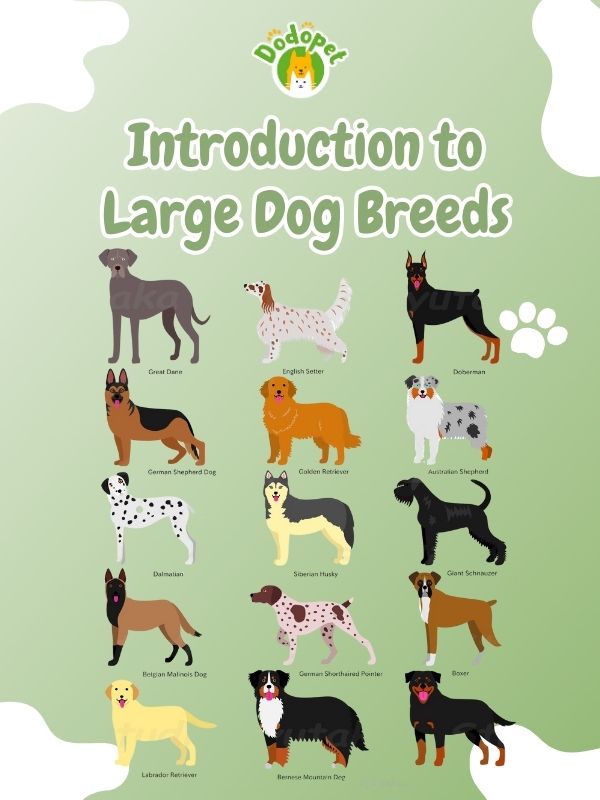In the diverse world of dog breeds, there’s a category that stands out for its sheer size, presence, and endearing personalities – the big types of dogs. From gentle giants to powerful protectors, these majestic canines capture our attention and leave an indelible mark on our lives. In this blog post, we’ll explore the world of these remarkable breeds, their unique characteristics, how to care and training tips. Whether you’re already a fan of big dogs or simply curious about the breeds that command our hearts, read on to discover the awe-inspiring world of these magnificent canines.
Introduction to Large Dog Breeds
Large dog breeds encompass a diverse and impressive group of canines that captivate us with their commanding presence, strength, and unique personalities. These magnificent dogs come in a wide range of shapes, temperaments, and abilities, each offering something special to their owners. Whether you’re drawn to the gentle giants, the protective powerhouses, or the loyal working dogs, large breeds have a lot to offer in terms of companionship, loyalty, and even specific skills and talents.
The Benefits of Owning Big Types of Dogs
Owning large dogs can be a rewarding and enriching experience for many individuals and families. These magnificent canines bring a unique set of benefits to their owners. Here are some of the advantages of owning large dogs:
- Loyal Companionship: Large dogs are often known for their unwavering loyalty and devotion to their owners. They form strong bonds with their families and provide a deep sense of companionship and security.
- Guardian and Protector: Many large dog breeds have protective instincts, making them excellent guard dogs. Their presence alone can act as a deterrent to potential intruders, enhancing your home’s security.
- Physical Activity: Large dogs typically require more exercise and outdoor activities. This encourages owners to stay active and enjoy regular walks and playtime, promoting a healthier lifestyle for both the dog and their human companions.
- Playful and Affectionate: Despite their size, many large breeds are known for their playful and affectionate nature. They can be gentle giants, particularly with children, making them excellent family pets.
- Versatile Working Dogs: Several large breeds have been bred for specific tasks, such as herding, search and rescue, or assistance work. These dogs are highly trainable and can excel in various roles.
- Unique Personalities: Large dogs often exhibit unique and endearing personalities. They can be goofy, majestic, or regal, depending on the breed, providing entertainment and emotional connection to their owners.
- A Sense of Security: Large dogs provide a sense of security and safety to their owners. Their presence can help individuals feel more secure, especially when living alone or in a rural setting.
- Human-Animal Bond: The strong bond that often forms between large dogs and their owners can be incredibly fulfilling and emotionally rewarding. This bond can provide a sense of purpose and comfort.
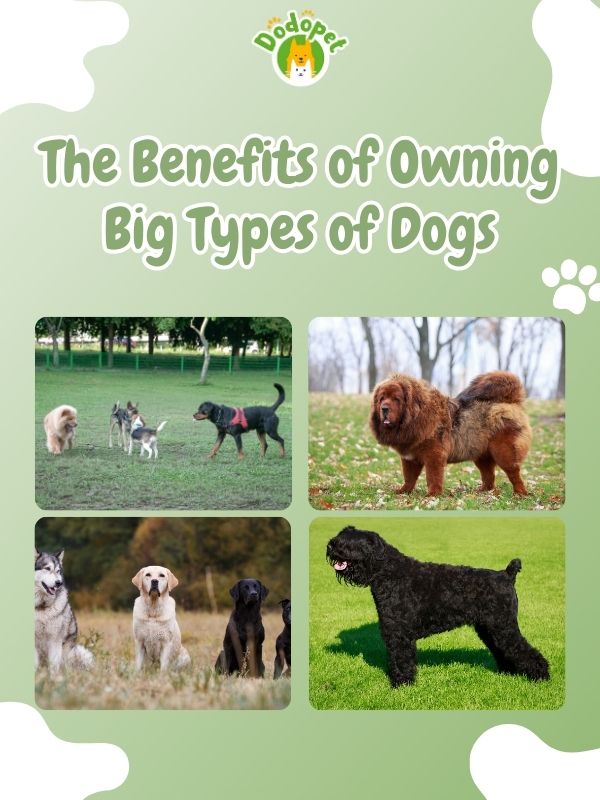
The Benefits of Owning Big Types of Dogs
Characteristics to Consider when Choosing a Big Types of Dogs
When choosing a large breed dog, it’s crucial to consider various characteristics to ensure a suitable match for your lifestyle and preferences. Here are key factors to keep in mind when selecting a large dog breed:
- Size and Space: Consider the size of the dog and whether your living space can accommodate a larger breed comfortably. Ensure you have enough room for the dog to move and exercise.
- Energy Level: Different large breeds have varying energy levels. Some are highly active, while others are more laid-back. Choose a breed that aligns with your activity level and exercise routine.
- Temperament: Research the breed’s temperament to ensure it matches your personality and living situation. Some large breeds are protective, while others are gentle and sociable.
- Exercise Needs: Large dogs typically require regular exercise to stay healthy and happy. Determine whether you can provide the necessary physical activity, such as long walks and playtime.
- Grooming Requirements: Large breeds may have different grooming needs. Some may have long coats that require regular grooming, while others have short, low-maintenance fur.
- Training: Consider the trainability of the breed. Some large dogs are highly trainable and eager to please, while others may be more independent and require patient and consistent training.
- Health and Longevity: Research common health issues associated with the breed and understand their average lifespan. Choose a breed known for good health, and consider adopting from reputable breeders or rescues.
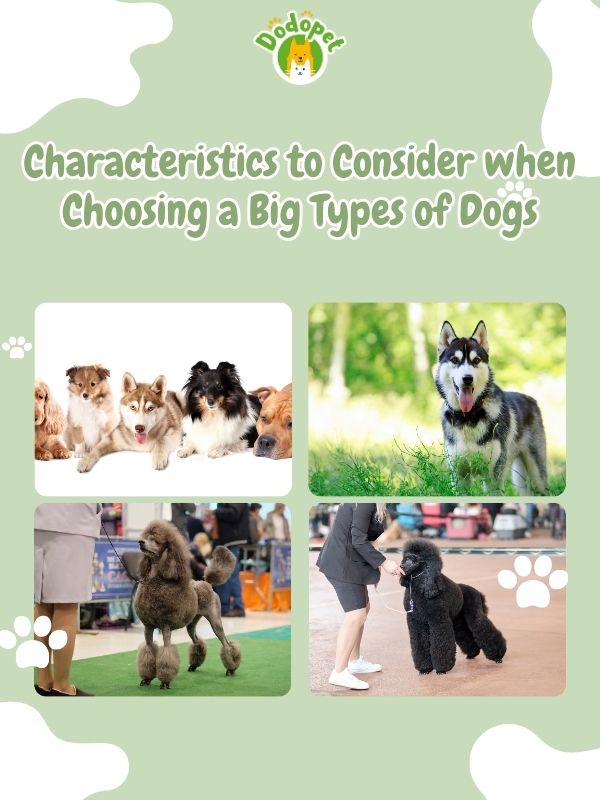
Characteristics to Consider when Choosing a Big Types of Dogs
Popular Large Dog Breeds for Families
Large dog breeds can make wonderful additions to families, offering loyalty, protection, and affection. Here are some popular large dog breeds known for their family-friendly nature:
- Golden Retriever: Golden Retrievers are friendly, intelligent, and gentle, making them one of the most beloved family breeds. They are great with kids and adaptable to various living environments.
- Labrador Retriever: Labs are known for their playful and outgoing personalities. They are excellent family dogs, highly trainable, and good with children.
- Bulldog: Bulldogs are calm, affectionate, and well-suited to family life. They have a sturdy build and are known for their loyalty.
- Boxer: Boxers are energetic and playful, making them great companions for active families. They are known for their affectionate and protective nature.
- Collie: Collies, such as the Rough Collie and Border Collie, are intelligent and responsive dogs. They are loyal and great with children.
- Newfoundland: Newfoundlands are gentle giants known for their sweet disposition. They are excellent family pets and are particularly good with kids.
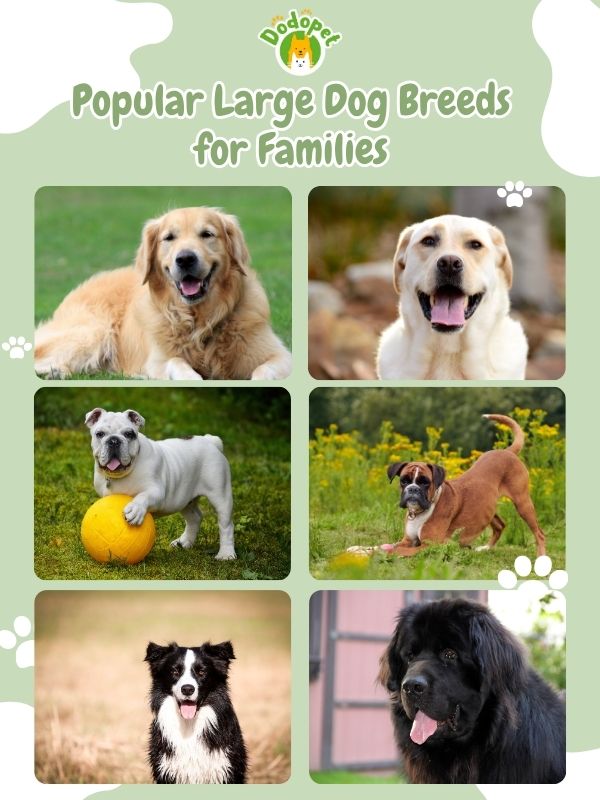
Popular Large Dog Breeds for Families
How to Care for Big Types of Dogs
Caring for big types of dogs requires attention to their specific needs, which can differ from those of smaller breeds due to their size, exercise requirements, and potential health issues. Here are some essential tips on how to care for large dogs:
- Provide Adequate Space: Ensure your home or living space can comfortably accommodate a large dog. They need room to move around and stretch their legs.
- Balanced Diet: Feed a high-quality, balanced diet appropriate for the dog’s age and size. Consult with your veterinarian to determine the best diet and portion sizes for your specific breed.
- Regular Exercise: Large dogs often require more exercise to stay healthy and happy. Provide daily walks, playtime, and mental stimulation to prevent boredom and excess energy.
- Training and Socialization: Early training and socialization are essential to ensure good behavior and positive interactions with people and other animals. Enroll in obedience classes if necessary.
- Grooming: Large breeds may have specific grooming needs. Regular brushing, bathing, and nail trimming are important to keep their coat and overall hygiene in check.
- Healthcare: Schedule regular veterinary check-ups to monitor your dog’s health. Large breeds are prone to certain health issues, so preventive care is crucial.
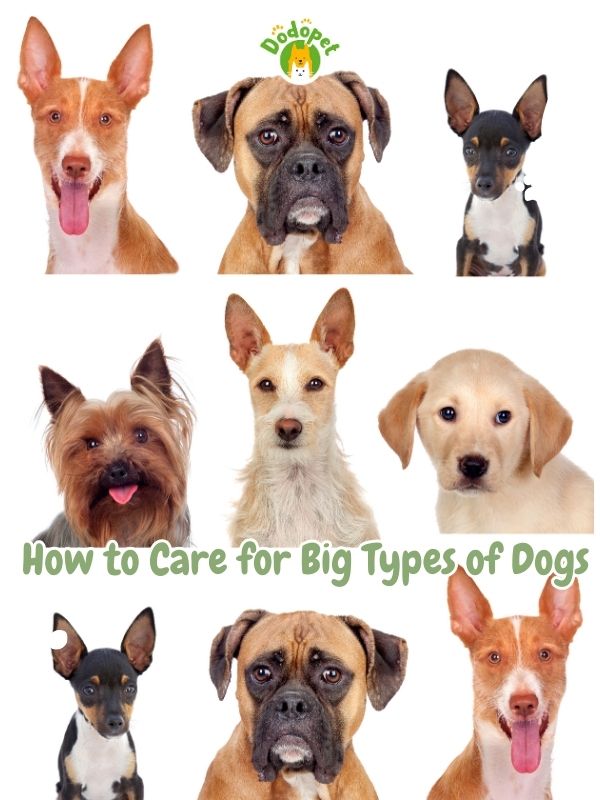
How to Care for Big Types of Dogs
Training Tips for Large Breed Dogs
Training bigs types of dogs can be a rewarding experience, but it comes with its unique challenges and considerations. Here are some training tips specifically tailored to large breed dogs:
- Start Early: Begin training and socialization as early as possible. Puppies are more receptive to learning at a young age, and it’s crucial for large breeds to develop good behavior habits.
- Positive Reinforcement: Use positive reinforcement techniques, such as treats, praise, and toys, to reward and motivate your large dog during training. This encourages them to repeat desired behaviors.
- Consistency: Be consistent in your commands and expectations. Large dogs, like all dogs, thrive on routine and clear communication. Use the same cues for specific actions.
- Socialization: Expose your large dog to a variety of people, animals, and environments from an early age. This helps them become well-adjusted and confident in different situations.
- Basic Obedience: Focus on teaching basic obedience commands like sit, stay, down, come, and leave it. These are essential for safety and control, especially with large and strong dogs.
- Leash Training: Teach leash manners to prevent pulling on walks. Large breeds can be powerful, so leash training is crucial for both your dog’s safety and your comfort.
- Training Equipment: Consider using appropriate training equipment, such as a front-clip harness, to help manage your large dog’s behavior while on walks.
- Use a Crate: Crate training can be especially useful for large dogs, as it provides them with a safe and comfortable space. Use the crate for housetraining and as a positive space for your dog.
- Exercise: Ensure your dog gets ample exercise to release energy and reduce the likelihood of behavioral problems. Daily physical activity can also improve focus during training sessions.
- Mental Stimulation: In addition to physical exercise, provide mental stimulation through puzzle toys and training exercises. Large dogs are intelligent and benefit from mental challenges.
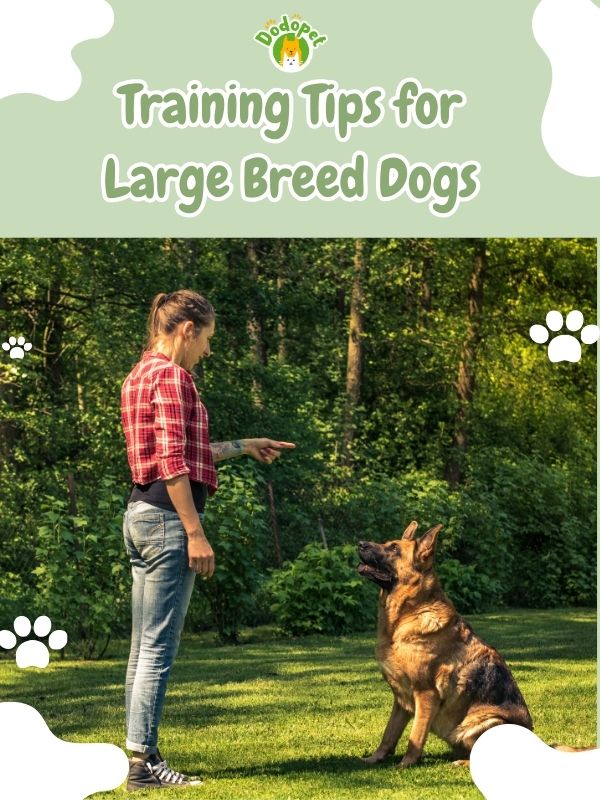
Training Tips for Large Breed Dogs
Conclusion
In conclusion, big types of dogs are a testament to the incredible diversity within the canine world. From the gentle giants that offer unwavering loyalty and affection to the noble protectors that ensure our safety, these remarkable breeds hold a special place in our hearts. Their size, strength, and distinctive personalities make them truly unforgettable companions.
As we’ve explored in this blog post, each big dog breed comes with its own set of characteristics, temperaments, and care needs. Whether you’re considering adding a large dog to your family or you’re simply fascinated by these majestic canines, one thing is certain – they have a way of leaving an indelible mark on our lives.
So, whether you’re a proud owner of a big dog or you’ve found newfound appreciation for these magnificent creatures, let’s celebrate the incredible world of big types of dogs and the unique joy they bring to our lives. For more insights, breed profiles, and heartwarming stories about these majestic companions, stay tuned for more content on ‘big types of dogs’ right here.

